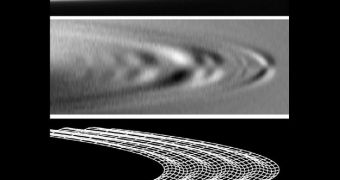A collaboration of investigators from the United States has recently determined that ripples observable in the ice rings surrounding the planet Saturn were most likely produced by cometary collisions.
The experts propose that cometary fragments that struck the gas giant about 10 years ago are responsible for generating these ripples, which have been closely observed using NASA spacecraft.
The Cassini, Galileo and New Horizons space probes all analyzed the event. New Horizons did so only in passing, on its way to Pluto and the Kuiper Belt. But Cassini has been observing the gas giant since July 1, 2004, when it achieved orbital insertion around the planet.
Ring ripples similar to Saturn's were also discovered around Jupiter, a planet that was investigated by the Galileo spacecraft. Researchers behind the new study say that the same type of creation mechanisms most likely apply here as well.
During the new investigation, experts determined that comet Shoemaker-Levy 9 was the most likely culprit for the ripples that developed in Jupiter's rings. The event took place in July 1994, and some astronomers got a chance to see the devastation as it occurred.
In the case of Saturn, the most likely culprit for the ripples is believed to be a cloud of cometary debris that struck the planetary system in 1983. The objects may have literally plunged through the inner rings on their suicide course to the planet.
Details of the new studies appear in a pair of papers experts published in the March 31 online issue of the top journal Science. One of the most important conclusions of the new work was that such large-scale disruption can be attributed to events that took place in the recent past.
“What's cool is we're finding evidence that a planet's rings can be affected by specific, traceable events that happened in the last 30 years, rather than a hundred million years ago,” Matthew Hedman explains.
“The solar system is a much more dynamic place than we gave it credit for.” adds the expert, who is the lead author of one of the new papers. The Cornell University research associate is also a member of the Cassini imaging team.
The orbiter was able to determine the existence of ripples in Saturn's rings in August 2009, as the planet reached equinox. Straight-on lighting from the Sun allowed the space probe to see a number of waves and ripples in the ice rings that were never discovered before.
“Finding these fingerprints still in the rings is amazing and helps us better understand impact processes in our solar system,” explains Cassini project scientist Linda Spilker. She holds an appointment at the Pasadena, California-based NASA Jet Propulsion Laboratory (JPL).
“Cassini's long sojourn around Saturn has helped us tease out subtle clues that tell us about the history of our origins,” she concludes.

 14 DAY TRIAL //
14 DAY TRIAL //